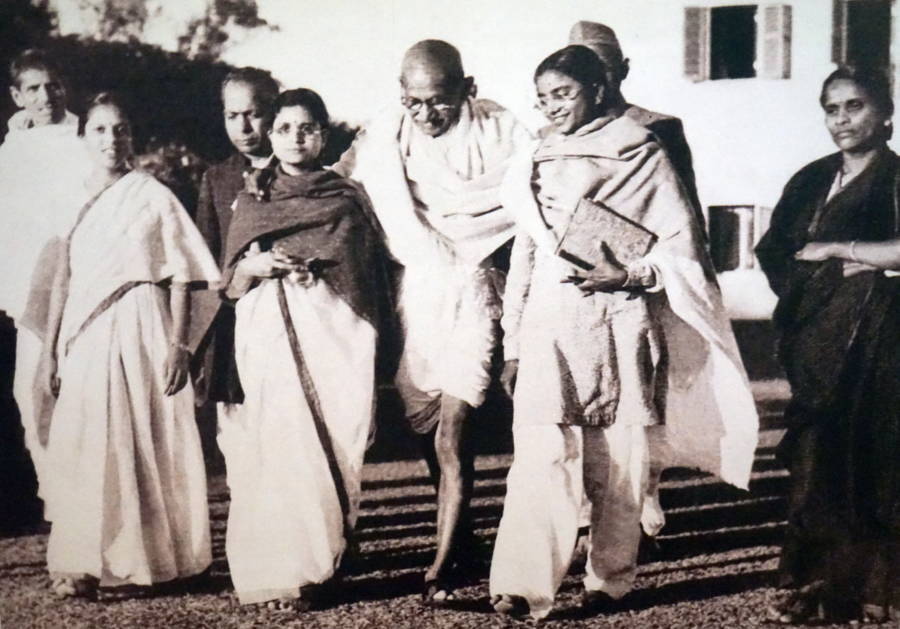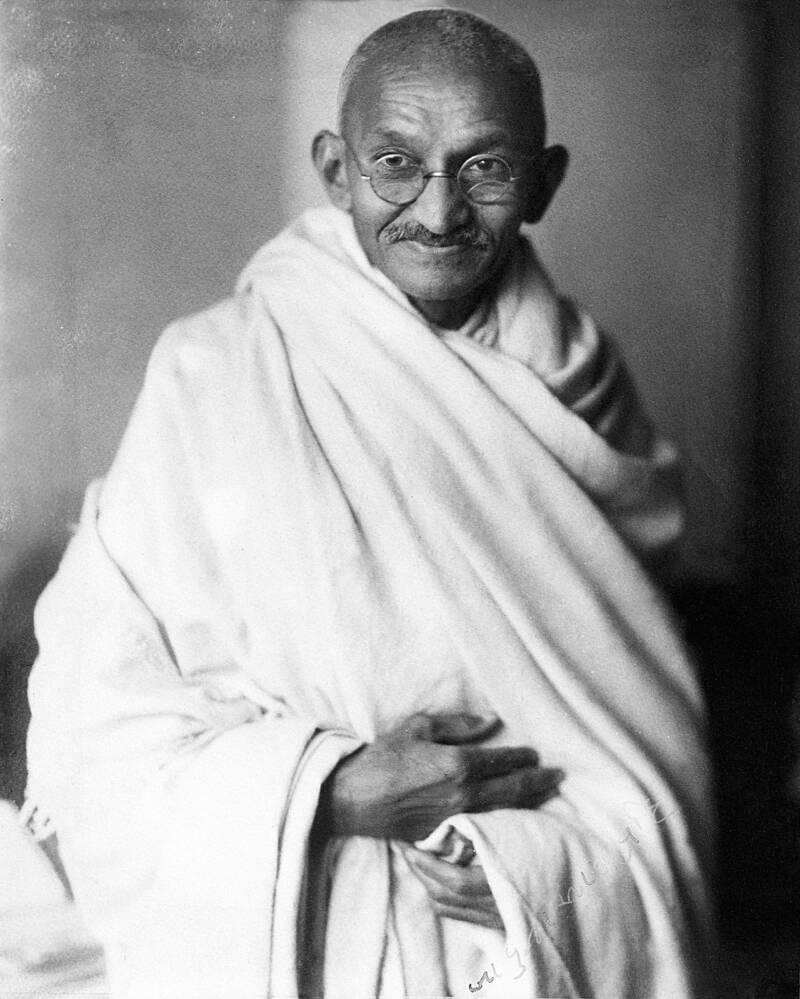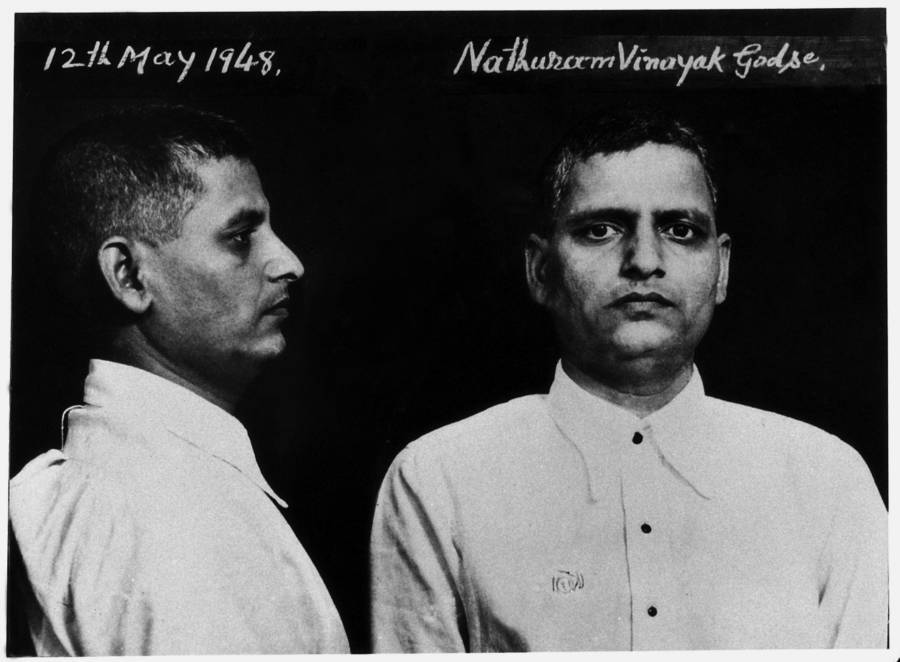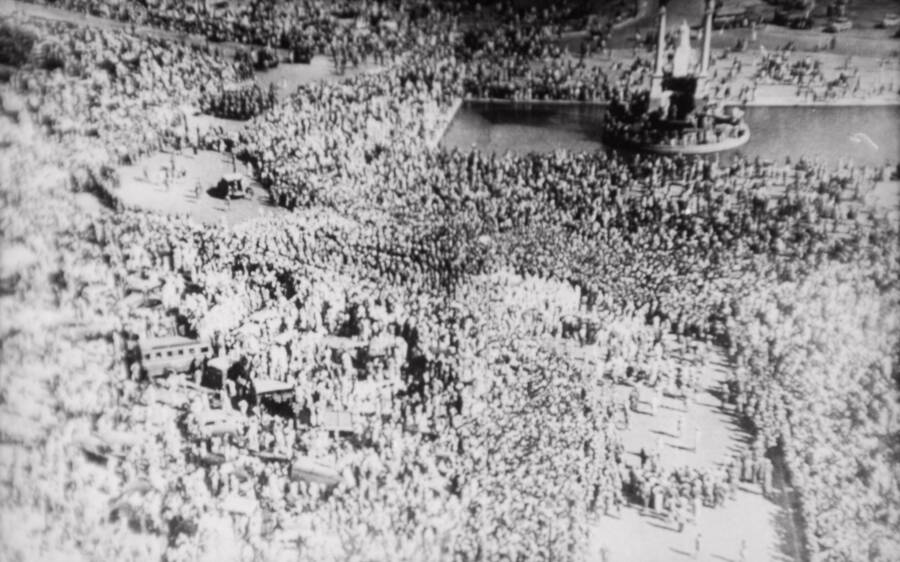Just months after leading the independence of India from the British in 1947, Gandhi was shot three times at point-blank range by a Hindu extremist named Nathuram Godse.

Universal History Archive/UIG via Getty ImagesOne of the last photos taken before Mahatma Gandhi’s assassination.
Mahatma Gandhi’s assassination on January 30, 1948, shocked the world. Just the year before, the nonviolent activist achieved his life’s goal when the British withdrew from India and the country celebrated their first ever Independence Day.
But that milestone achievement would lead to Gandhi’s death a few short months later.
Gaining independence from an imperial power left the Indian subcontinent divided, and many blamed the violence surrounding this partition on Gandhi. Although Gandhi had opposed dividing the territory along religious lines, extremists nonetheless accused him of taking sides. Gandhi listened as enemies cried out, “Let Gandhi die!”
On his final day, Gandhi was weak with fasting and was being led across the gardens of Birla House where he was living when a Hindu fanatic named Nathuram Godse stepped out of the crowd. He bowed before Gandhi, then stood and shot him three times at point-blank range in the stomach and chest.
This is the shocking story of Mahatma Gandhi’s death at the hands of a religious zealot.
Mahatma Gandhi Battles Against Partition
In 1947, British rule in India ended. But the British left behind a major question: would the territory remain united, or would it split into two states based on religious beliefs?
During World War II, religious violence polarized the colony. Many advocated for a two-state solution, with East and West Pakistan governing over majority Muslim areas while India would govern a majority Hindu nation. Muslim League leader Muhammad Ali Jinnah argued for a partition along religious lines, in part to protect the minority Muslim populations in the British colony.
The question of partition divided Indians. Gandhi originally opposed partition as he believed that splitting the subcontinent along religious lines would create more violence. Instead, Gandhi recommended uniting across religious barriers.

Wikimedia CommonsA portrait of Mahatma Gandhi from 1931.
Unfortunately, Gandhi’s prediction of violence proved true. When the British withdrew, they handed power to the new states of India and Pakistan — and religious violence quickly swept across the new nations. Riots broke out, especially along the borders of the new territories.
Ultimately, partition displaced 15 million people, and the violence claimed one million lives.
Gandhi’s advocacy for nonviolence earned him enemies. To some Hindus, Gandhi’s way meant leaving themselves open to attacks. Others felt that Gandhi was too soft on Muslims, unfairly siding with them against Hindus.
Then, on Jan. 20, 1948, Gandhi barely escaped an assassination attempt when a radical group of Hindus set off a bomb mere yards from the 78-year-old.
“If I am to die by the bullet of a madman, I must do so smiling,” Gandhi said after the fact. “There must be no anger within me. God must be in my heart and on my lips.”
Gandhi also had a message for the radicals who thought he favored Muslims. “Don’t do this,” Gandhi begged. “The Hindu religion is not going to be saved by such acts. I insist that if the Hindu religion is to be saved, it can be saved only through the kind of work I am doing.”
Rather than running from death, Gandhi embraced it. “Death for me would be a glorious deliverance rather than that I should be a helpless witness of the destruction of India, Hinduism, Sikhism, and Islam.” He said this in the days leading up to his brutal execution.
Then, ten days later, an assassin reached Gandhi and killed him.
On The Day Of Gandhi’s Assassination
On Jan. 30, 1948, Mahatma Gandhi walked out of Birla House in Delhi around 5 p.m. Weak from completing his last fast, Gandhi was led by his grandnieces to a prayer meeting where thousands of his supporters were awaiting him.
Then, a Hindu zealot named Nathuram Vinayak Godse.
Godse believed Gandhi had betrayed his fellow Hindus by taking pro-Muslim stances. So he brought a Beretta automatic pistol to Delhi and planned to kill him.
But before doing so, Godse bowed to Gandhi in a mock show of greeting. When he stood, he fired three shots — they hit Gandhi in the chest and stomach.

Mondadori Portfolio via Getty ImagesNathuram Vinayak Godse, the zealot who killed Gandhi.
At the moment before his assassination, Gandhi raised his hands in a Hindu greeting gesture. Then, when the shots hit, he fell to the ground, his grandnieces at his sides.
In the chaos after Gandhi’s death, Godse tried to shoot himself. But as a mob of enraged Gandhi supporters yelled “Kill him, kill him,” authorities seized Godse and placed him under arrest.
One year later, a court sentenced Gandhi’s assassin to death. Godse was hanged in November 1949.
The Icon’s Funeral And Legacy
News of the peaceful leader’s death reached the media within the hour.
That night, India’s first Prime Minister Jawaharlal Nehru addressed the nation. He announced Gandhi’s death and his funeral the next day.
“Gandhi has gone out of our lives and there is darkness everywhere,” Nehru announced. “The father of our nation is no more.”

Wikimedia CommonsA crowd of nearly one million people lined the procession for the fallen icon’s funeral.
“Now that the light has gone out of our lives I do not quite know what to tell you and how to say it,” Nehru added. “Our beloved leader is no more.”
One paper reported, “The crowds insisted they wished to see Gandhi’s face once more … All roads to Birla House were jammed.”
A crowd of nearly one million lined up for the funeral procession that crossed Delhi to the Jumna River.
The five-mile procession took five hours. Planes dropped flowers on the crowd. At the end of the procession, Gandhi’s body was burned on a sandalwood funeral pyre.
In spite of his message of nonviolence, riots and arson broke out in the wake of Gandhi’s death. Rioters targeted members of extremist groups. In Bombay, police even fired into crowds. It was a terrible legacy for a man devoted to peace.
In the decades after Gandhi’s death, his reputation for political activism and his efforts to gain independence for India influenced generations. But his warning about partition also proved true.
He would have gladly given his life for peace. Unfortunately, even his death could not heal the divide between India and Pakistan.
Mahatma Gandhi’s assassination divided India. Next, read about other assassinations that shook up history, like that of Martin Luther King Jr. or Abraham Lincoln.





